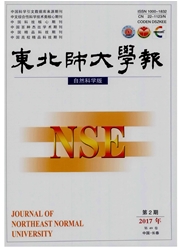

 中文摘要:
中文摘要:
比较研究了中国长白山和俄罗斯符拉迪沃斯托克地区大耳蝠(Plecotusauritus)飞行状态下的回声定位声波.结果表明,二者的回声定位声波均为微弱、不稳定的多谐波宽频带短调频型(modulatedfrequency).长白山大耳蝠回声定位声波由1~4个谐波组成,主频(45.4±9.6)kHz,能率环(5.1±2.5)Yoo;符拉迪沃斯托克地区大耳蝠的回声定位声波由2~4个谐波组成,主频(48.0±9.7)kHz,能率环(7.0±3.1)%.二者的最高频率、最低频率、带宽、能率环以及声强均有显著差异.这种差异可能是由地理差异或性别差异等因素引起的.
 英文摘要:
英文摘要:
Plecotus auritus were captured in Changbai mountains,China and Vladivostok,Russia,and their echolocation calls emitted when flying were studied. The echolocation calls were multiple modulated frequency (FM) signals which could be characterized as weak, unstable, wide bandwidth and short duration. P. auritus captured in Changbai mountains used echolocation calls which including 1~ 4 harmonics,with the highest frequency (65. 9±6. 2)kHz,the lowest frequency (29.0±5.5)kHz, dominant frequency (45.4±9.6)kHz and duty cycle (5.1±2.5)%; However,P. auritus captured in Vladivostok used echolocation calls which including 2 ~ 4 harmonics, with the highest frequency (80.1±8.3 kHz,the lowest frequency (24. 5±4. 4) kHz, dominant frequency (48. 0±9. 7)kHz and duty cycle (7.0±3. 1)%. The results showed that there were significant differences on the highest frequency, the lowest frequency, bandwidth, duty cycle and power, but no significant differences on duration,interpulse interval and dominant frequency. Geographic variation or sexual differences may account for the echolocation call variation between P. auritus which captured in Changbai mountains and Vladivostok.
 同期刊论文项目
同期刊论文项目
 同项目期刊论文
同项目期刊论文
 Response to seasonal change of insect resources in Changbai Mountain temperate forests by Greater Ho
Response to seasonal change of insect resources in Changbai Mountain temperate forests by Greater Ho Seasonal habitat use by greater horseshoe bat Rhinolophus ferrumequinum(Chiroptera: Rhinolophidae) i
Seasonal habitat use by greater horseshoe bat Rhinolophus ferrumequinum(Chiroptera: Rhinolophidae) i Plasticity in echolocation calls of Myotis macrodactylus (Chiroptera:Vespertionidae): implications f
Plasticity in echolocation calls of Myotis macrodactylus (Chiroptera:Vespertionidae): implications f Postnatal development of morphological features and vocalization in the pomona leaf-nosed bat Hippos
Postnatal development of morphological features and vocalization in the pomona leaf-nosed bat Hippos Phylogeography and population genetic structure of the great leaf-nosed bat (Hipposideros armiger) i
Phylogeography and population genetic structure of the great leaf-nosed bat (Hipposideros armiger) i Molecular systematics of the Chinese Myotis (Chiroptera, Vespertilionidae) inferred from cytochrome-
Molecular systematics of the Chinese Myotis (Chiroptera, Vespertilionidae) inferred from cytochrome- 期刊信息
期刊信息
